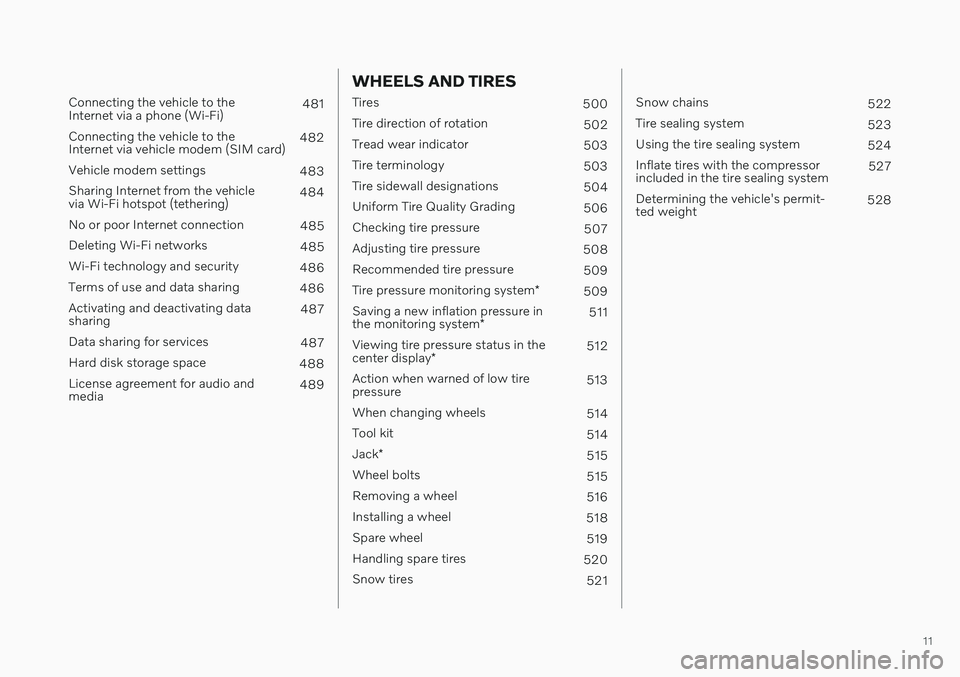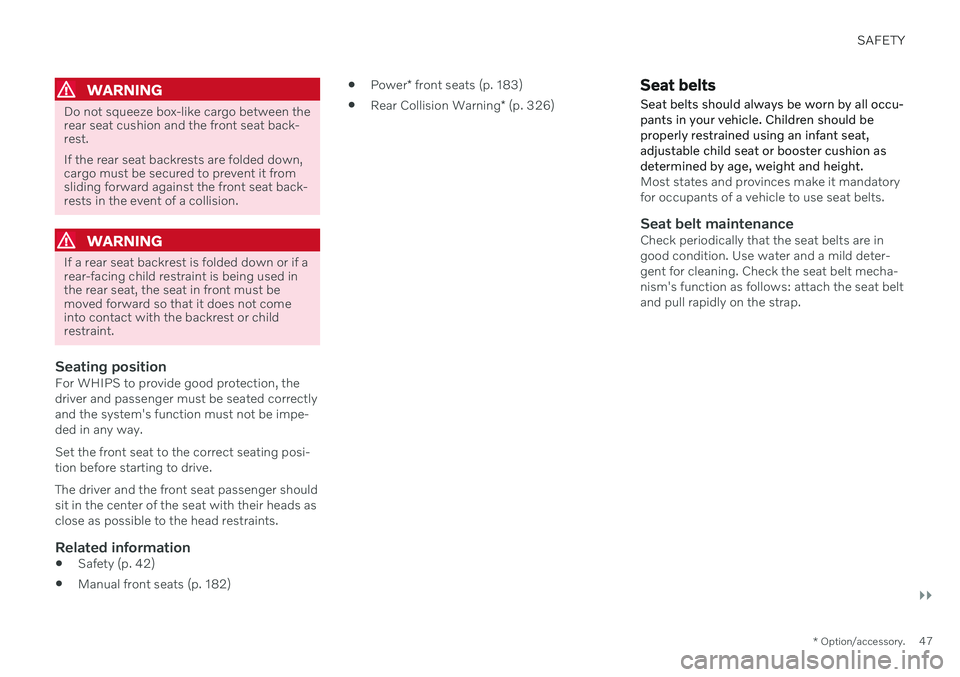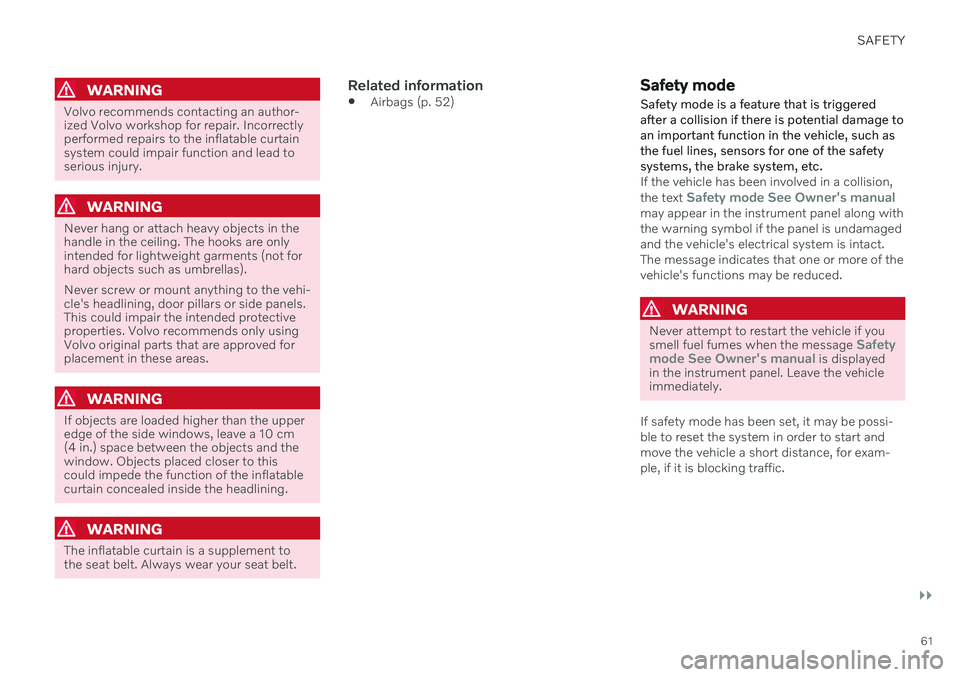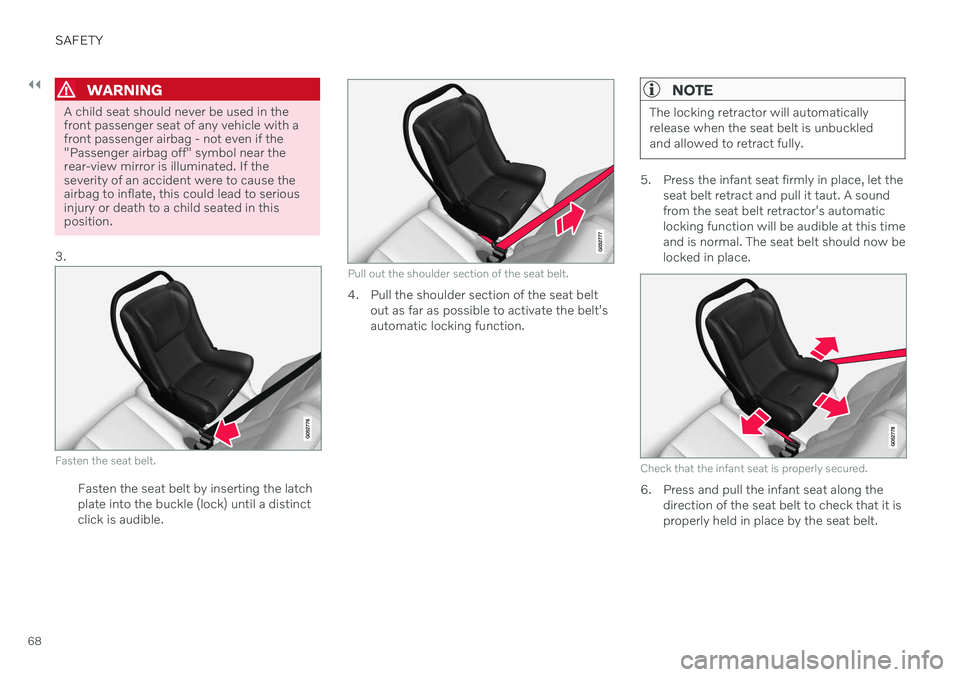ECU VOLVO S90 2020 Quick Guide
[x] Cancel search | Manufacturer: VOLVO, Model Year: 2020, Model line: S90, Model: VOLVO S90 2020Pages: 643, PDF Size: 13.68 MB
Page 13 of 643

11
Connecting the vehicle to the Internet via a phone (Wi-Fi)481
Connecting the vehicle to theInternet via vehicle modem (SIM card) 482
Vehicle modem settings 483
Sharing Internet from the vehiclevia Wi-Fi hotspot (tethering) 484
No or poor Internet connection 485
Deleting Wi-Fi networks 485
Wi-Fi technology and security 486
Terms of use and data sharing 486
Activating and deactivating datasharing 487
Data sharing for services 487
Hard disk storage space 488
License agreement for audio andmedia 489
WHEELS AND TIRES
Tires
500
Tire direction of rotation 502
Tread wear indicator 503
Tire terminology 503
Tire sidewall designations 504
Uniform Tire Quality Grading 506
Checking tire pressure 507
Adjusting tire pressure 508
Recommended tire pressure 509
Tire pressure monitoring system *
509
Saving a new inflation pressure in the monitoring system *511
Viewing tire pressure status in thecenter display * 512
Action when warned of low tire pressure 513
When changing wheels 514
Tool kit 514
Jack *
515
Wheel bolts 515
Removing a wheel 516
Installing a wheel 518
Spare wheel 519
Handling spare tires 520
Snow tires 521
Snow chains522
Tire sealing system 523
Using the tire sealing system 524
Inflate tires with the compressor included in the tire sealing system 527
Determining the vehicle's permit-ted weight 528
Page 36 of 643

||
YOUR VOLVO
34Canadian market only: This vehicle is equipped with an “Event Data Recorder” (EDR). The main purpose of theEDR is to register and record data in trafficaccidents or accident-like situations, e.g. if anairbag deploys or if the vehicle hits an obstaclein the road. This data is recorded in order tohelp understand how the vehicle's systemsperform in these types of situations. The EDRis designed to record data related to vehicledynamics and safety systems for a shortperiod of time, usually 30 seconds or less. The EDR in this vehicle is designed to record data in traffic accidents or accident-like situa-tions such as:
How the various systems in the vehicleperformed;
Whether the driver and passenger seatbelts were tightened/buckled;
The driver's use of the accelerator/brakepedal;
How fast the vehicle was moving.
This data can help provide a better under-standing of the circumstances in which trafficaccidents and injuries occur. The EDR records data only if a non-trivial accident situation occurs. EDR does not record any data duringnormal driving conditions. The system alsonever registers data on who is driving the vehi-cle or the geographical location of the acci- dent or near-accident. However, other parties,such as law enforcement, could combine theEDR data with the type of personally identifia-ble information that is routinely acquired dur-ing an accident investigation. Special equip-ment and access to either the vehicle or theEDR is required to read this recorded data. In addition to the EDR, the vehicle is equipped with a number of computers that continuouslycontrol and monitor the vehicle's performance.These computers may record data during nor-mal driving conditions, particularly if theydetect a fault relating to the vehicle's opera-tion and functionality or upon activation of thevehicle's active driver support functions (e.g.City Safety or the auto-brake function). Some of this recorded data is required by technicians performing service and mainte-nance in order to diagnose and rectify anyfaults that may have occurred in the vehicle.The recorded information is also needed toenable Volvo to fulfill legal and other regula-tory requirements. Information registered inthe vehicle is stored in its computers until thevehicle is serviced or repaired. In addition to the above, the recorded informa- tion may be used in aggregated form forresearch and product development purposesin order to continuously improve the safetyand quality of Volvo vehicles.
Volvo will not provide this information to anythird parties without the vehicle owner's con-sent. However, national legislation and regula-tions may require Volvo to disclose this type ofinformation to law enforcement or otherauthorities that can claim a legal right to theinformation. Special technical equipment,which Volvo and workshops that have enteredagreements with Volvo have access to, isrequired to read and interpret the recordeddata. Volvo is responsible for ensuring thatinformation provided to Volvo in conjunctionwith service and maintenance is stored andhandled securely and in compliance withapplicable legal requirements. For more infor-mation, please contact a Volvo retailer.
Related information
Contacting Volvo (p. 26)
Volvo Structural Parts Statement (p. 39)
Page 49 of 643

SAFETY
}}
* Option/accessory.47
WARNING
Do not squeeze box-like cargo between the rear seat cushion and the front seat back-rest. If the rear seat backrests are folded down, cargo must be secured to prevent it fromsliding forward against the front seat back-rests in the event of a collision.
WARNING
If a rear seat backrest is folded down or if a rear-facing child restraint is being used inthe rear seat, the seat in front must bemoved forward so that it does not comeinto contact with the backrest or childrestraint.
Seating positionFor WHIPS to provide good protection, the driver and passenger must be seated correctlyand the system's function must not be impe-ded in any way. Set the front seat to the correct seating posi- tion before starting to drive. The driver and the front seat passenger should sit in the center of the seat with their heads asclose as possible to the head restraints.
Related information
Safety (p. 42)
Manual front seats (p. 182)
Power
* front seats (p. 183)
Rear Collision Warning
* (p. 326)
Seat belts
Seat belts should always be worn by all occu- pants in your vehicle. Children should beproperly restrained using an infant seat,adjustable child seat or booster cushion asdetermined by age, weight and height.
Most states and provinces make it mandatory for occupants of a vehicle to use seat belts.
Seat belt maintenanceCheck periodically that the seat belts are ingood condition. Use water and a mild deter-gent for cleaning. Check the seat belt mecha-nism's function as follows: attach the seat beltand pull rapidly on the strap.
Page 63 of 643

SAFETY
}}
61
WARNING
Volvo recommends contacting an author- ized Volvo workshop for repair. Incorrectlyperformed repairs to the inflatable curtainsystem could impair function and lead toserious injury.
WARNING
Never hang or attach heavy objects in the handle in the ceiling. The hooks are onlyintended for lightweight garments (not forhard objects such as umbrellas). Never screw or mount anything to the vehi- cle's headlining, door pillars or side panels.This could impair the intended protectiveproperties. Volvo recommends only usingVolvo original parts that are approved forplacement in these areas.
WARNING
If objects are loaded higher than the upper edge of the side windows, leave a 10 cm(4 in.) space between the objects and thewindow. Objects placed closer to thiscould impede the function of the inflatablecurtain concealed inside the headlining.
WARNING
The inflatable curtain is a supplement to the seat belt. Always wear your seat belt.
Related information
Airbags (p. 52)
Safety mode Safety mode is a feature that is triggered after a collision if there is potential damage toan important function in the vehicle, such asthe fuel lines, sensors for one of the safetysystems, the brake system, etc.
If the vehicle has been involved in a collision, the text Safety mode See Owner's manualmay appear in the instrument panel along with the warning symbol if the panel is undamagedand the vehicle's electrical system is intact.The message indicates that one or more of thevehicle's functions may be reduced.
WARNING
Never attempt to restart the vehicle if you smell fuel fumes when the message Safety
mode See Owner's manual is displayed
in the instrument panel. Leave the vehicle immediately.
If safety mode has been set, it may be possi- ble to reset the system in order to start andmove the vehicle a short distance, for exam-ple, if it is blocking traffic.
Page 65 of 643

SAFETY
}}
63
WARNING
When the vehicle is in safety mode, it should not be towed behind another vehi-cle. It should be towed from the site on atow truck. Volvo recommends towing thevehicle directly to an authorized Volvoworkshop.
Related information
Safety mode (p. 61)
Starting the vehicle (p. 378)
Recovery (p. 425)
Child safety Children should always be seated safely when traveling in the vehicle.
General informationVolvo recommends the proper use of restraint systems for all occupants including children.Remember that, regardless of age and size, achild should always be properly restrained in avehicle. Your vehicle is also equipped with ISOFIX/ LATCH attachments, which make it more con-venient to install child seats. Some restraint systems for children are designed to be secured in the vehicle by lapbelts or the lap portion of a lap-shoulder belt.Such child restraint systems can help protectchildren in vehicles in the event of an accidentonly if they are used properly. However, chil-dren could be endangered in a crash if thechild restraints are not properly secured in thevehicle. Failure to follow the installationinstructions for your child restraint can resultin your child striking the vehicle's interior in asudden stop. Holding a child in your arms is NOT a suitable substitute for a child restraint system. In anaccident, a child held in a person's arms canbe crushed between the vehicle's interior andan unrestrained person. The child could alsobe injured by striking the interior, or by being ejected from the vehicle during a suddenmaneuver or impact. The same can also hap-pen if the infant or child rides unrestrained onthe seat. Other occupants should also beproperly restrained to help reduce the chanceof injuring or increasing the injury of a child. All states and provinces have legislation gov- erning how and where children should be car-ried in a vehicle. Find out the regulations exist-ing in your state or province. Recent accidentstatistics have shown that children are safer inrear seating positions than front seating posi-tions when properly restrained. A childrestraint system can help protect a child in avehicle. Here's what to look for when selectinga child restraint system: It should have a label certifying that it meets applicable Federal Motor Vehicle SafetyStandards (FMVSS 213) - or in Canada,CMVSS 213. Make sure the child restraint system is approved for the child's height, weight anddevelopment - the label required by the stand-ard or regulation, or instructions for infantrestraints, typically provide this information. In using any child restraint system, we urge you to carefully look over the instructions thatare provided with the restraint. Be sure youunderstand them and can use the device prop-erly and safely in this vehicle. A misused childrestraint system can result in increased inju-
Page 67 of 643

SAFETY
}}
65
Volvo has some very specific recommendations
Always wear your seat belt.
Airbags are a SUPPLEMENTAL safety device which, when used with a three-point seat belt can help reduce seriousinjuries during certain types of accidents.Volvo recommends that you do not dis-connect the airbag system in your vehicle.
Volvo strongly recommends that everyonein the vehicle be properly restrained.
Volvo recommends that ALL occupants(adults and children) shorter than 140 cm(4 feet 7 inches) be seated in the rear seatof any vehicle with a front passenger sideairbag.
Drive safely!
Related information
Safety (p. 42)
Child restraints (p. 65)
Activating and deactivating child safetylocks (p. 254)
Child restraints
Suitable child restraints should always be used when children travel in the vehicle.
Child restraint systems
Infant seat
There are three main types of child restraint systems: infant seats, convertible seats andbooster cushions. They are classified accord-ing to the child's age and size. The child restraint should be secured using a three-point seat belt, ISOFIX/LATCH anchorsor top tether anchors.
Convertible seat
WARNING
A child seat should never be used in the front passenger seat of any vehicle with afront passenger airbag - not even if the"Passenger airbag off" symbol near therear-view mirror is illuminated. If theseverity of an accident were to cause theairbag to inflate, this could lead to seriousinjury or death to a child seated in thisposition.
Page 68 of 643

||
SAFETY
66
Booster cushion
WARNING
Always refer to the child restraint manufac- turer's instructions for detailed informationon securing the restraint.
WARNING
When not in use, keep the child restraint system secured or remove itfrom the passenger compartment tohelp prevent it from injuring passen-gers in the event of a sudden stop orcollision.
A small child's head represents a con-siderable part of its total weight and itsneck is still very weak. Volvo recom-mends that children up to age 4 travel,properly restrained, facing rearward. Inaddition, Volvo recommends that chil-dren should ride rearward facing, prop-erly restrained, as long as possible.
NOTE
Prolonged installation and use of the child restraint may damage the vehicle's interior.Volvo recommends using the kick guardaccessory to help protect the vehicle'sinterior.
Automatic Locking Retractor/ Emergency Locking Retractor (ALR/ELR)
To make child seat installation easier, each seat belt (except for the driver's belt) is equip-ped with a locking mechanism to help keepthe seat belt taut.
When attaching the seat belt to a child seat:
1. Attach the seat belt to the child seat
according to the child seat manufacturer's instructions.
2. Pull the seat belt out as far as possible.
3. Insert the seat belt latch plate into the buckle (lock) in the usual way.
4. Release the seat belt and pull it taut around the child seat.
A sound from the seat belt retractor will be audible at this time and is normal. The belt willnow be locked in place. This function is auto-matically disabled when the seat belt isunlocked and the belt is fully retracted.
WARNING
Do not use child safety seats or child booster cushions/backrests in the frontpassenger's seat. We also recommend thatchildren who have outgrown these devicessit in the rear seat with the seat belt prop-erly fastened.
Child restraint registration and recallsChild restraints could be recalled for safety reasons. You must register your child restraintto be reached in a recall. To stay informedabout child safety seat recalls, be sure to fill
Page 69 of 643

SAFETY
}}
67
out and return the registration card that comes with new child restraints. Child restraint recall information is readily available in both the U.S. and Canada. Forrecall information in the U.S., call the U.S.Government's Auto Safety Hotline at1-800-424-9393 or go to http://www-odi.nhtsa.dot.gov/cars/problems/recalls/register/childseat/index.cfm. In Canada, visitTransport Canada's Child Safety website athttp://www.tc.gc.ca/roadsafety/childsafety/menu.htm.
Related information
Child safety (p. 63)
Infant seats (p. 67)
Convertible seats (p. 69)
Booster cushions (p. 72)
Top tether anchors (p. 73)
Lower child seat attachment points(p. 74)
ISOFIX/LATCH lower anchors (p. 75)
Infant seats
Suitable child restraints should always be used when children (depending on their age/size) are seated in the vehicle.
Securing an infant seat with a seat belt
Do not place the infant seat in the front passenger's seat.
1. Place the infant seat in the rear seat of the vehicle.
2. Attach the seat belt to the infant seat according to the child restraint manufac- turer's instructions.
Route the seat belt through the infant seat.
WARNING
An infant seat must be in the rear-facing position only.
The infant seat should not be positionedbehind the driver's seat unless there isadequate space for safe installation.
Page 70 of 643

||
SAFETY
68
WARNING
A child seat should never be used in the front passenger seat of any vehicle with afront passenger airbag - not even if the"Passenger airbag off" symbol near therear-view mirror is illuminated. If theseverity of an accident were to cause theairbag to inflate, this could lead to seriousinjury or death to a child seated in thisposition.
3.
Fasten the seat belt.
Fasten the seat belt by inserting the latch plate into the buckle (lock) until a distinctclick is audible.
Pull out the shoulder section of the seat belt.
4. Pull the shoulder section of the seat belt out as far as possible to activate the belt's automatic locking function.
NOTE
The locking retractor will automatically release when the seat belt is unbuckledand allowed to retract fully.
5. Press the infant seat firmly in place, let theseat belt retract and pull it taut. A sound from the seat belt retractor's automaticlocking function will be audible at this timeand is normal. The seat belt should now belocked in place.
Check that the infant seat is properly secured.
6. Press and pull the infant seat along thedirection of the seat belt to check that it is properly held in place by the seat belt.
Page 71 of 643

SAFETY
}}
69
WARNING
It should not be possible to move the child restraint more than 2.5 cm (1 in.) in anydirection along the seat belt path.
When installing infant seats in the rear seat, Volvo recommends maintaining a distance of at least50 mm (2 inches) from the front-most part of theinfant seat to the rearmost part of the seat in front.
The infant seat can be removed by unbuckling the seat belt and letting it retract completely.
Related information
Child restraints (p. 65)
Convertible seats (p. 69)
Booster cushions (p. 72)
Top tether anchors (p. 73)
Lower child seat attachment points(p. 74)
ISOFIX/LATCH lower anchors (p. 75)
Convertible seats Suitable child restraints should always be used when children (depending on their age/size) are seated in the vehicle.
Securing a convertible seat with a seat belt
Do not place the convertible seat in the front pas- senger's seat.
Convertible seats can be used in either a for- ward or rearward-facing position, dependingon the age and size of the child.